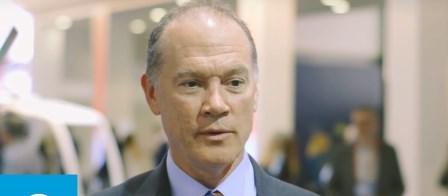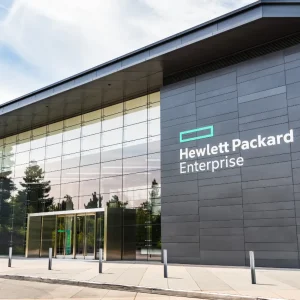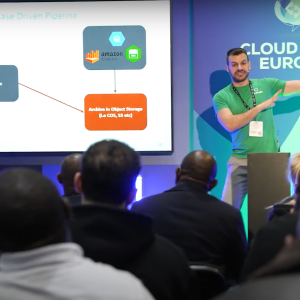
In the new world telecoms is reinventing itself. It is a world where suppliers become competitors and competitors become partners. A world where instead of looking at what Verizon or BT will do next it is more interesting and vital to see how Amazon and Google and the other web scale players are moving. This is a place where the standards based telecoms world must be replicated in networking if we are to fully benefit from a world which is flattening and where code moves quickly across borders.
John Donovan, chief strategy officer and group president at AT&T technology and operations explains.
"Everything is in the ecosystem. People that were suppliers are now competitors. People that were competitors are now partners in areas such as open source development. The tide way the whole industry worked is changing. Problems once went to standards bodies and standards bodies got everyone’s feedback and were carefully considered and we managed and we voted and put committees together and then we produced work product. That doesn’t play well when you’re playing against the web scale players that don’t operate behind those rules."
AT&T regularly meets with the web scale players in this new ecosystem. "We talk about how the services integrate while knowing they are going after our customers and knowing that we distribute a lot of their operating systems and that they’re playing pretty heavily against us in new regulatory areas. That’s just the new world we live in. You have to get over yourself," he says.
In regulation we want a level playing field. What we don’t want them to do is let the web scale guys off, he says.
In this world he says one has to identify the essential items that come out of the traditional approach and everything else has to be subject to change.
The number one essential is that of interoperability. "Some of those basics are we have to interoperate. You can’t pick up a phone and call Japan and worry about which network you’re touching to get there. You can’t reintroduce complexity. Our industry has always been very deliberate to ensure we didn’t have borders or boundaries that affected the customer."
This uniformity must be maintained across geographies to maintain consistency for the customer.
"We don’t want someone to go to a web site and click on it and have a different bi-flow if it was procured out of India rather than if it was procured out of the US. We have to preserve that uniformity but everything else needs to change."
He says of the Internet of Things space there are global compliance requirements. "We really have compliance requirements geographically and locally. We don’t view that as a geographic business. So when we provision a network for container companies, they want us to find a container anywhere in the globe. So it is important that we operate on a global footprint in the IOT, and that requires us to get active in partnering and procuring wireless networks."
Old transitions to new
There is says Mr Donovan, an old world and a new world. And the transition point was the line drawn in the recession of 2008 when the risk and reward profile of how technology is viewed within companies changed dramatically.
"Right at the heart of it is IP in the voice business. Prior to 08 you’d talk to customers and they’d say, ‘I understand this new stuff. I can do IP on my premise but I’m just not ready to change the processes or I’m not comfortable with the security or I don’t think those networks are tested enough. Then 08 happened and all IT budgets got slashed and the risk appetite changes. We found more companies looking to adopt technology. There was no longer much appetite to buy more of the same and everyone was investing in productivity business cases."
This caused a very fundamental shift in the trajectory of the industry because customer risk appetites changed. By 2010 there were lots of pilot tests and moving to the cloud and putting voice over IP and changing how they do conferencing.
"The whole customer adoption has been accelerating and Google and Amazon joining the fray has been very helpful. I don’t think it is uniformly true of everyone but having the web scale players talking to large enterprises globally and having very provocative business models has created a great opportunity," says Mr Donovan.
This required huge change.
Our role has changed – if three or four years ago you’d ask a customer what we were, they’d say ‘you are our carrier.’ And if you asked a multinational, they’d say, what AT&T do a good job at is making it all look the same to me. I buy a circuit in EMEA, in APAC, in the US and it all looks the same to me. And the service looks and feels the same, and it has redundancy and failover etc. You ask them today and they’d say we’re their integrator. Our large multi-national customers have said, ‘your role has changed. We don’t want you to be the carrier, we want you to be the integrator."
This aligns with the changing risk appetite for new technologies. Companies want to go to Azure to AWS or hybrid cloud.
Mr Donovan says AT&T has moved up the stack. "Many of our multinationals are saying I’ m going to be moving a lot of our workloads to the cloud and I want you to make sure the packets are passing. And it really is requiring us to operate at a higher level of the network."
Mr Donovan says AT&T is going all in and has surprises in store…
Mr Donovan says AT&T is going all in.
"You’re going to be surprised at what AT&T is capable of pulling off. If I sat here five years ago and said we intend to be the most aggressive IT company in the world – you’ve have looked and said – ‘not going to happen.’ There’s no one in the world at our scale that’s moved 80% of our applications to the cloud."
"If I told you that we’d have 5% of our network functions for the customer operating in the cloud, for the customer facing network and in a single year we’re going to take that from five to thirty, I’d dare you to say ‘not going to happen.’ We as a carrier are going to be able to come over the top – we’re going to have software and get dark fibre and be in the business. As we build out the technology we’re going to be bring to the fore some very difficult questions for competitors and suppliers and for regulators as well and I don’t think there is anything wrong with us pushing that envelope. Whether its connected cars in Europe or enterprise services in Mexico."
The customer sets the pace
"The comment we get from customers is why aren’t you going faster. Why aren’t you in this geography or that country? Network on demand is the fastest growing service we’ve ever had. This is software based bandwidth adjustment on the fly on prem at a customer. If we have fibre and electronics to your building we can have it running in four days and after that you can adjust your bandwidth consumption as you like by yourself. What took days now takes just over a minute through a portal and in the future it will be through an API which can take a particular workload or process and adjust the bandwidth needed for it."
Who owns the customer?
In telecoms there is significant debate about who owns the customer in a collaborative world.
"If I were debating it I’d say, we’re in the game. Is the industry in the game, I ‘m not sure. I think I’d tip to a no. I think awareness is high. I think readiness is mid to low. When we characterise internally, we don’t look at the pace of what our telecoms brethren are doing. That’s not at all the benchmarks.
We look at what the web scale players and the software folks are doing. It is inevitable that the big web scale players will slow down. It is inevitable that they will have to focus on reliability, that they’ll increase their footprint, that they’ll densify their data centres, so we are speeding up and shrinking down some of our infrastructure and their’s is growing. The question is will we land on the same point 24-36 months from now."
What remains constant is that for AT&T the irreducible is "We have to own the software, the network and the network operating system."






